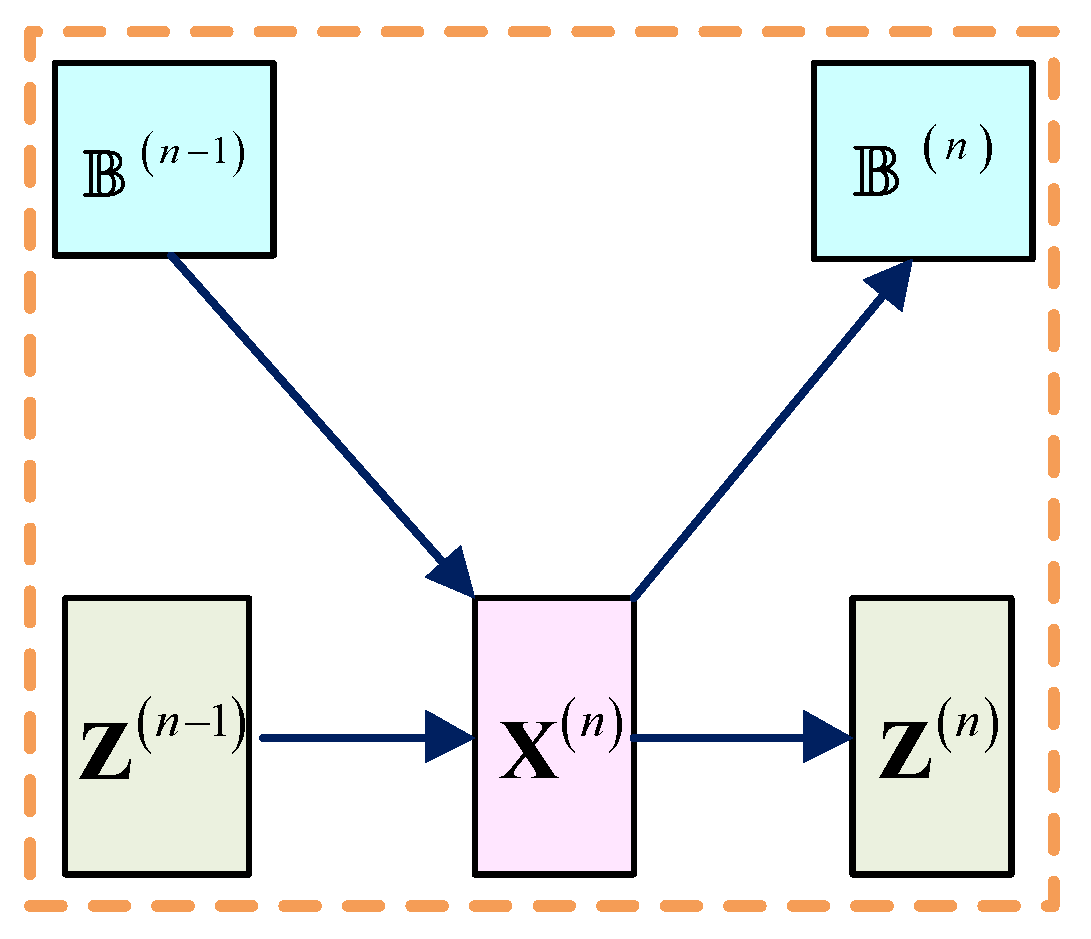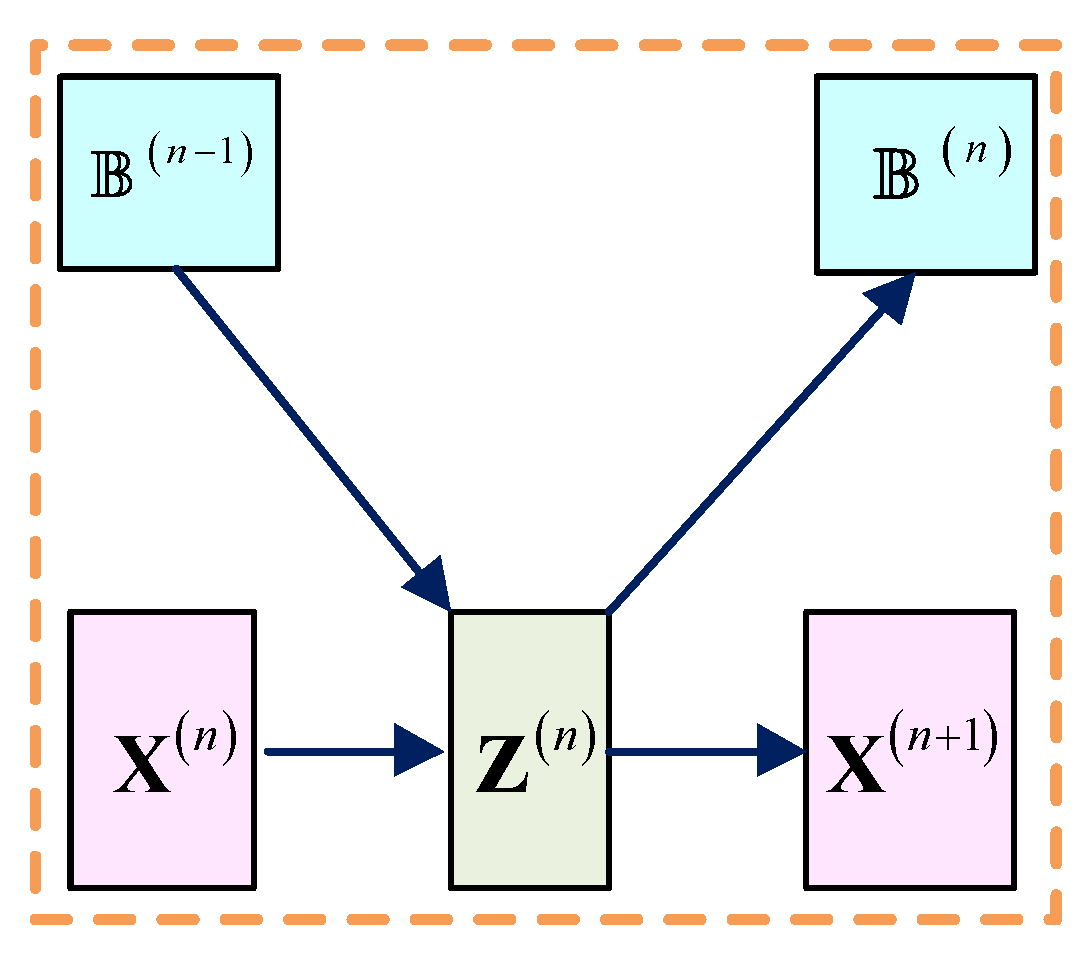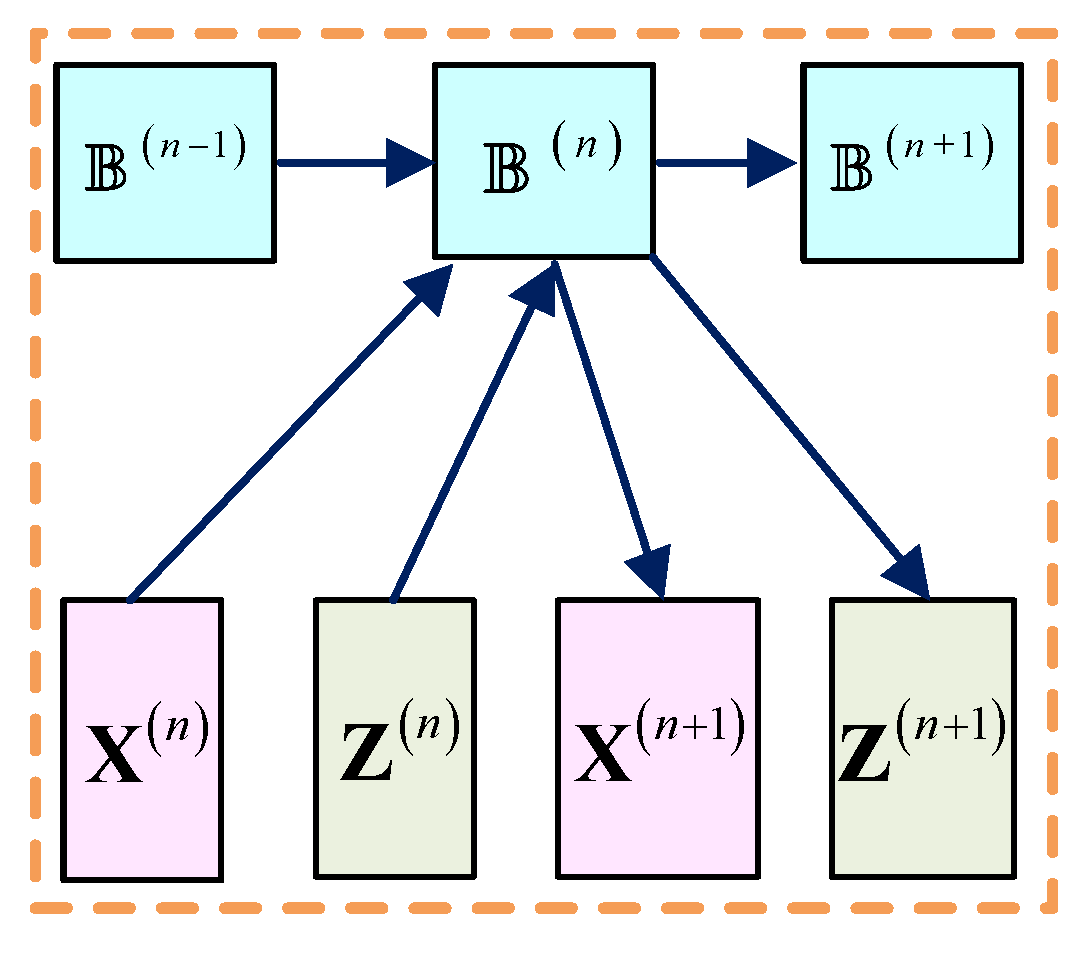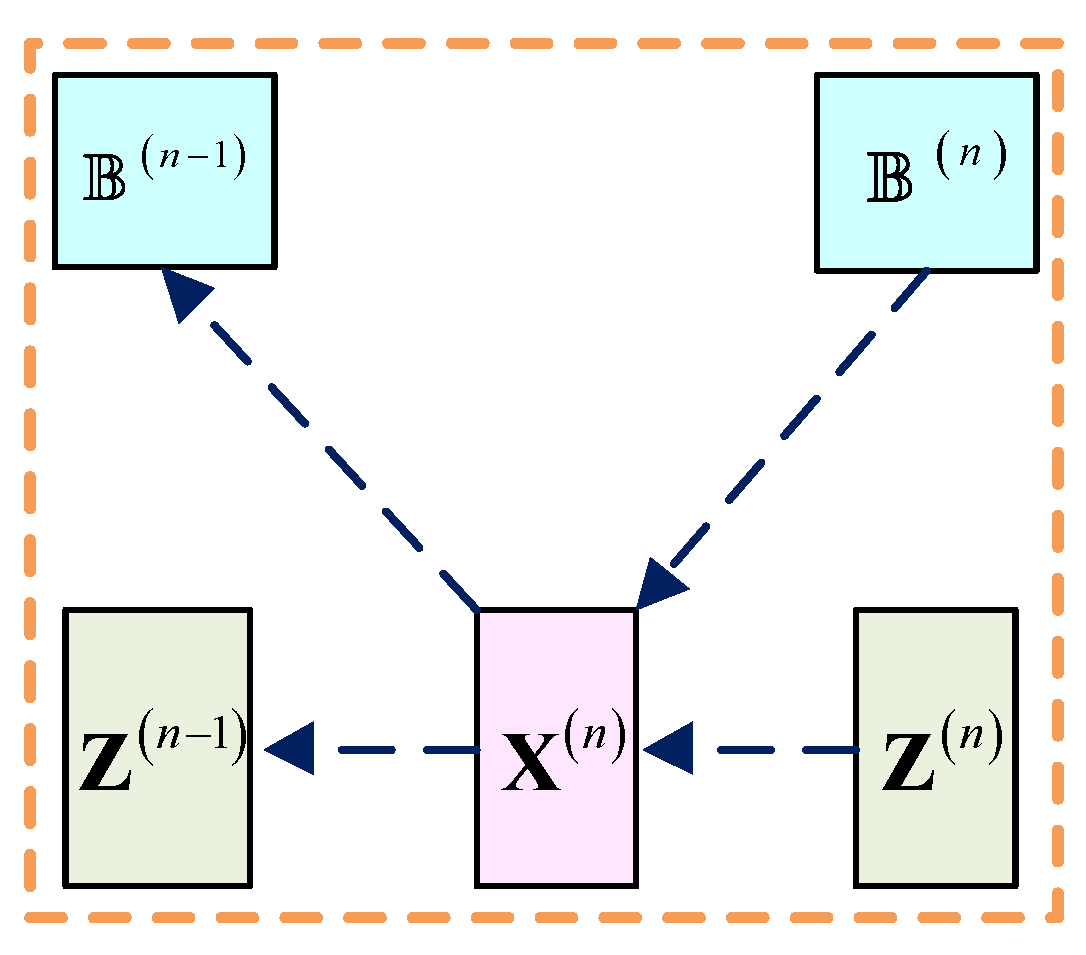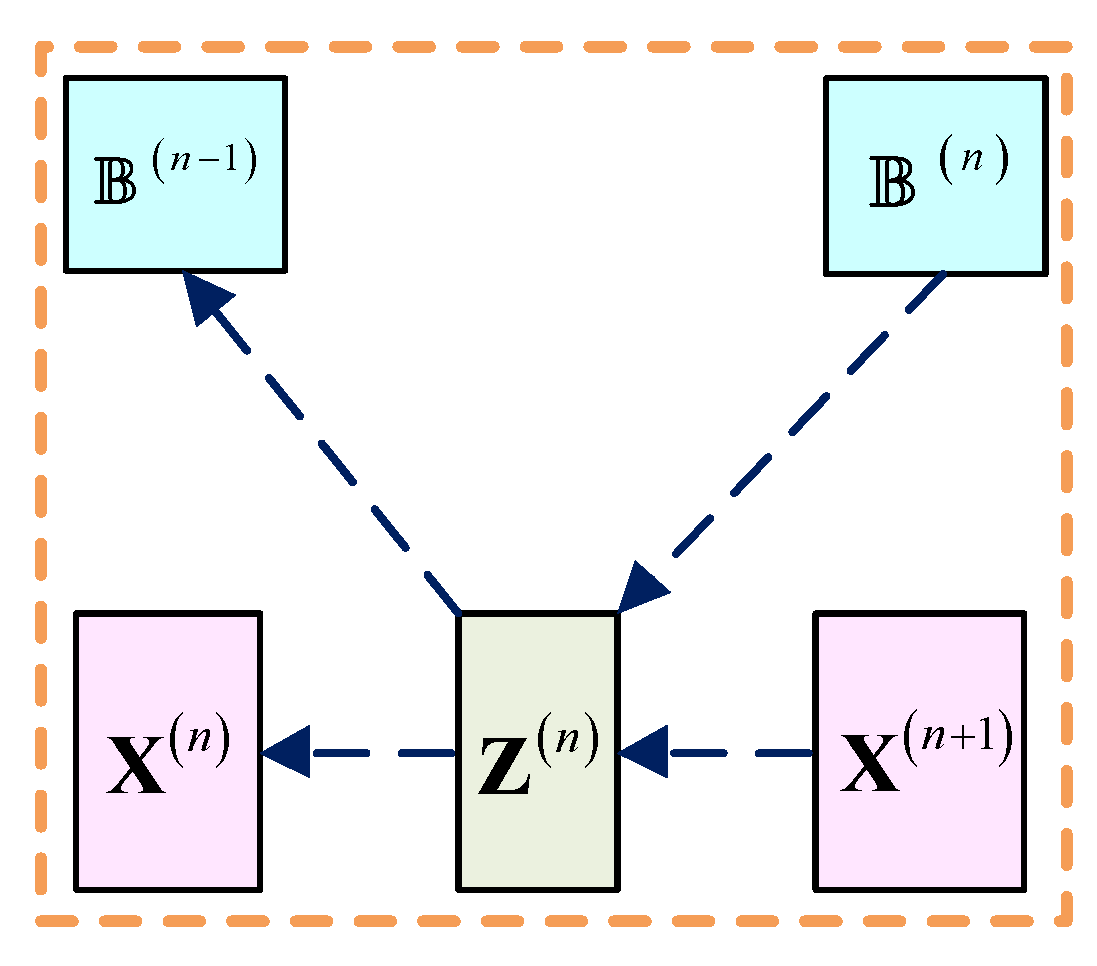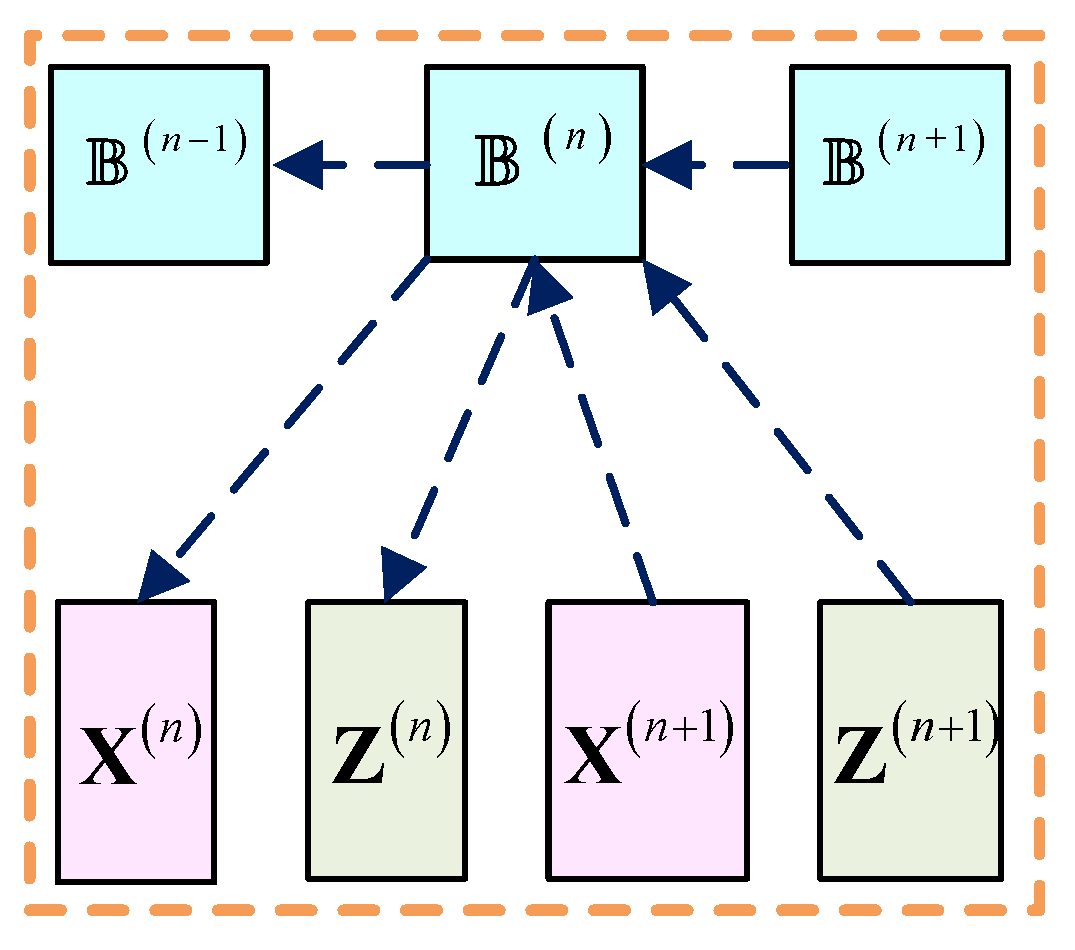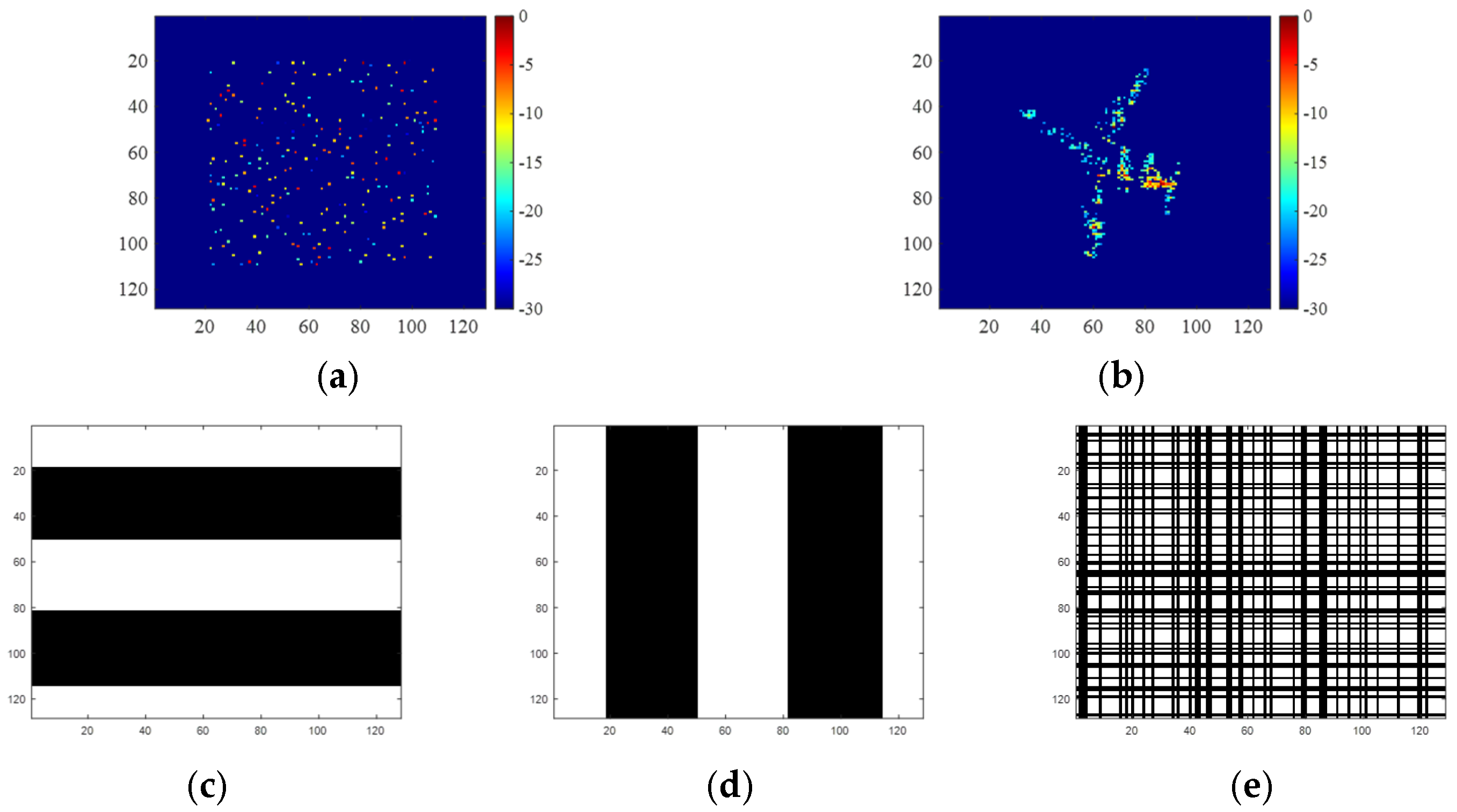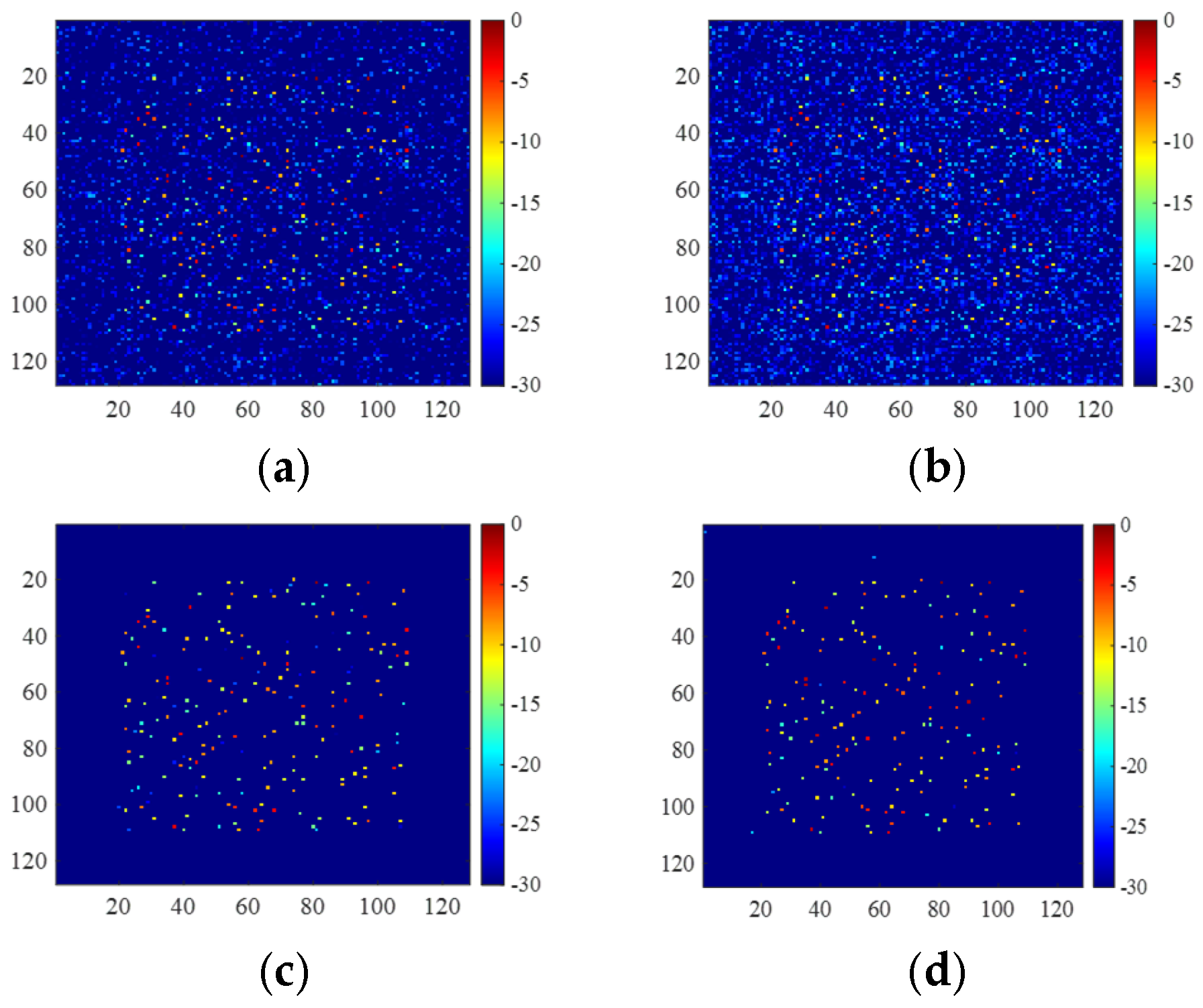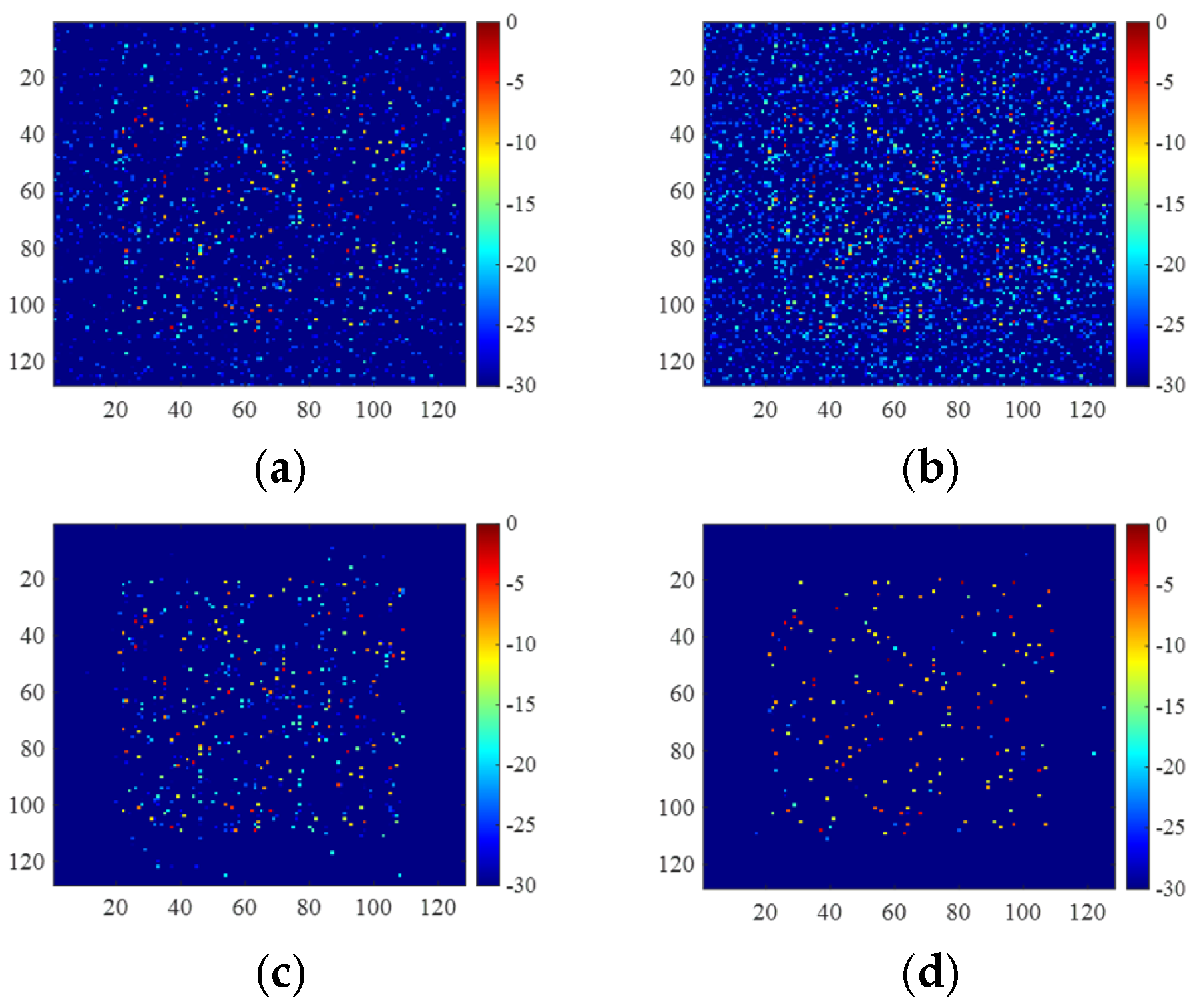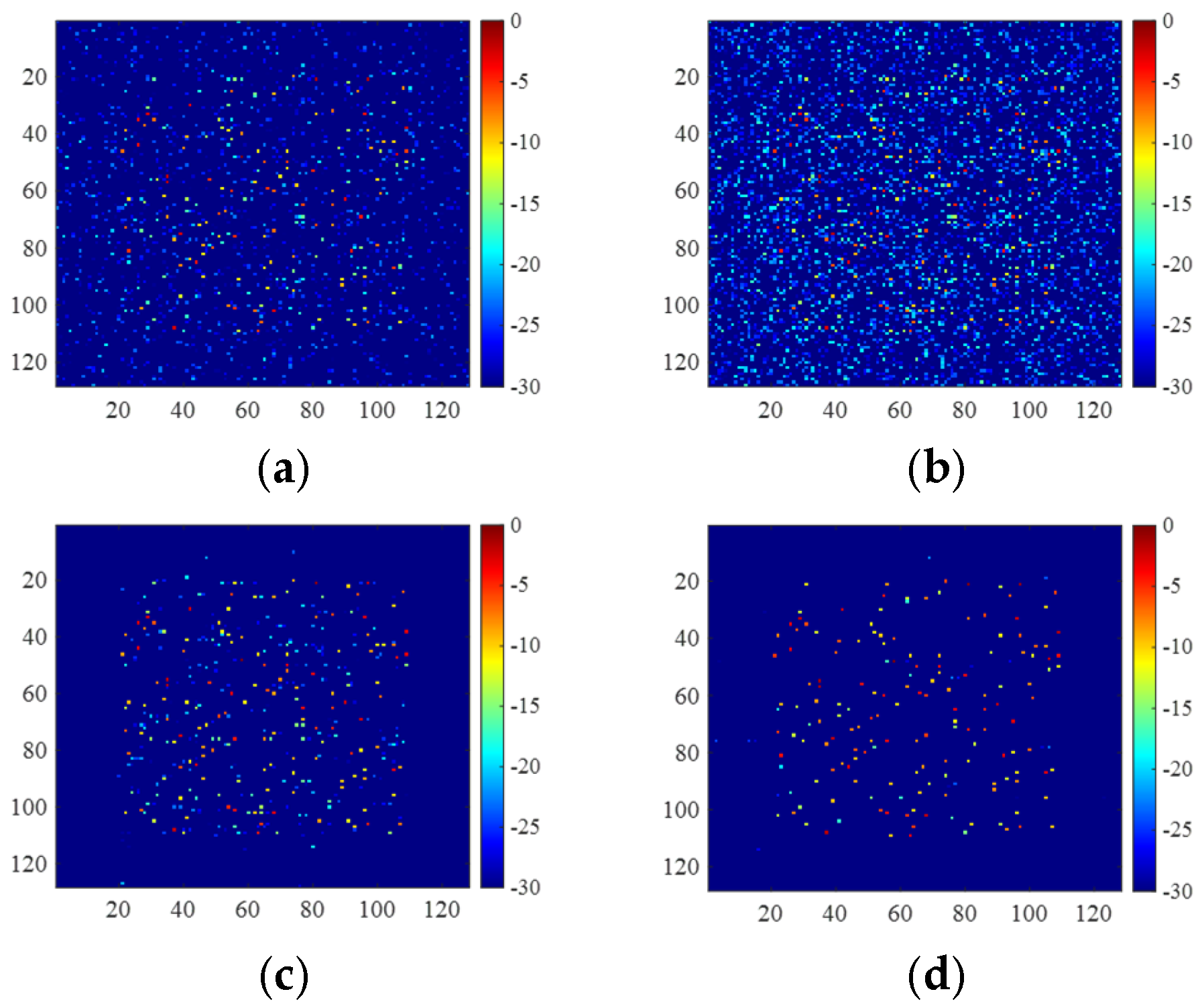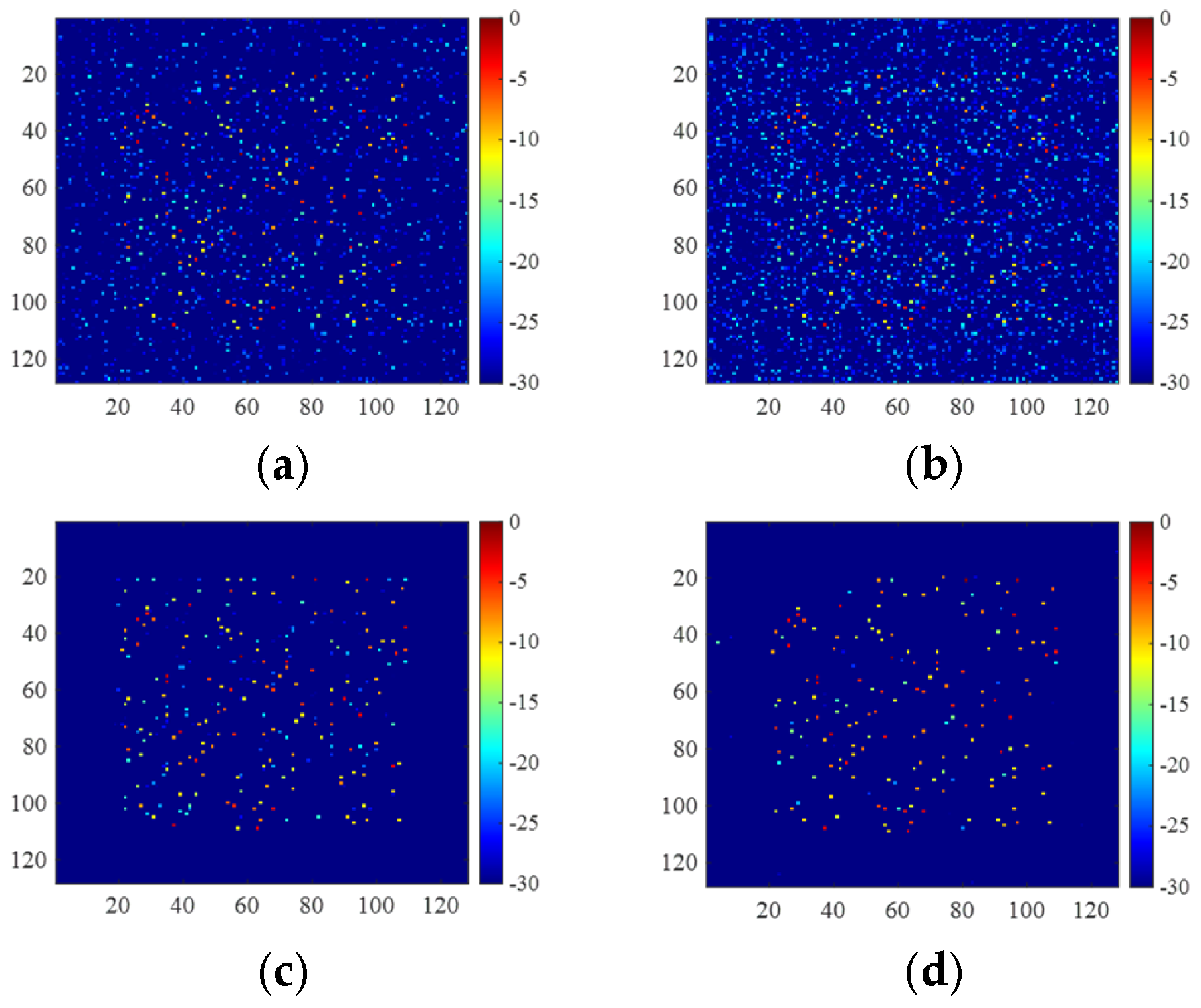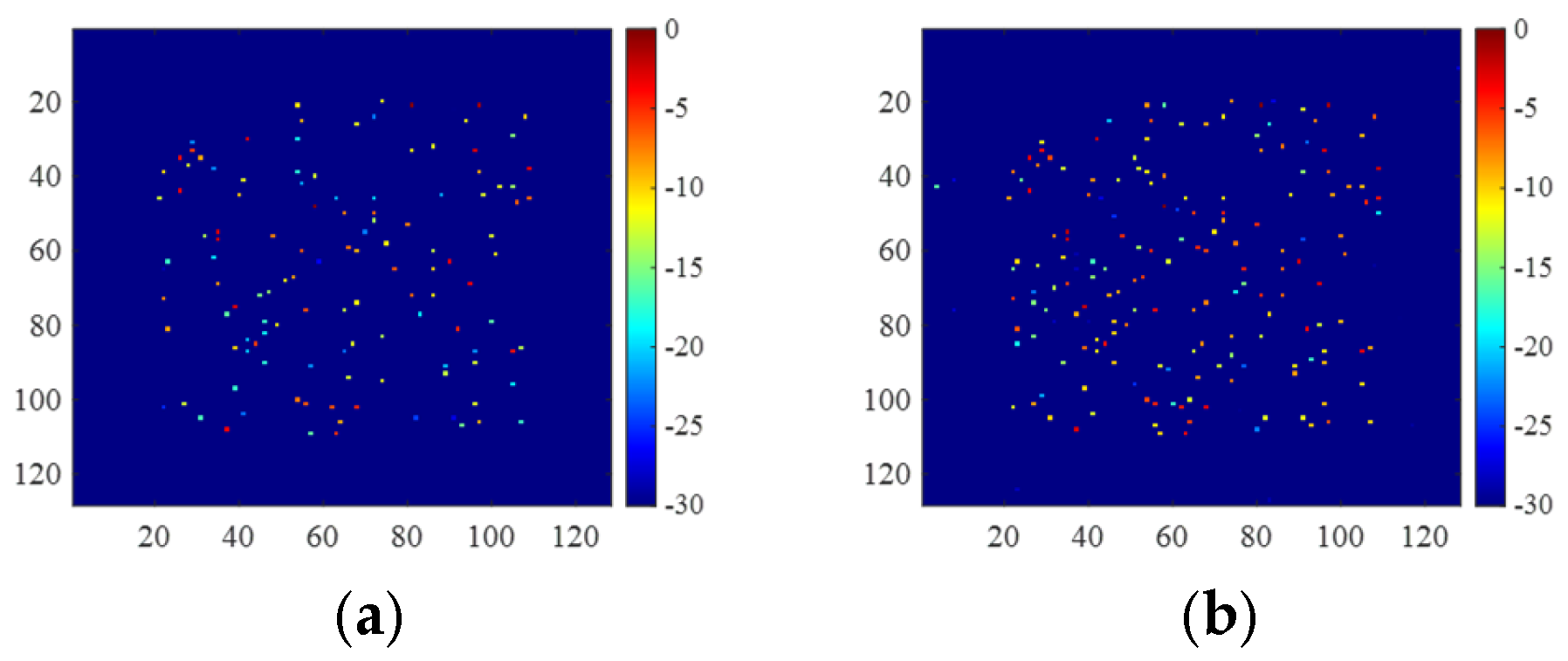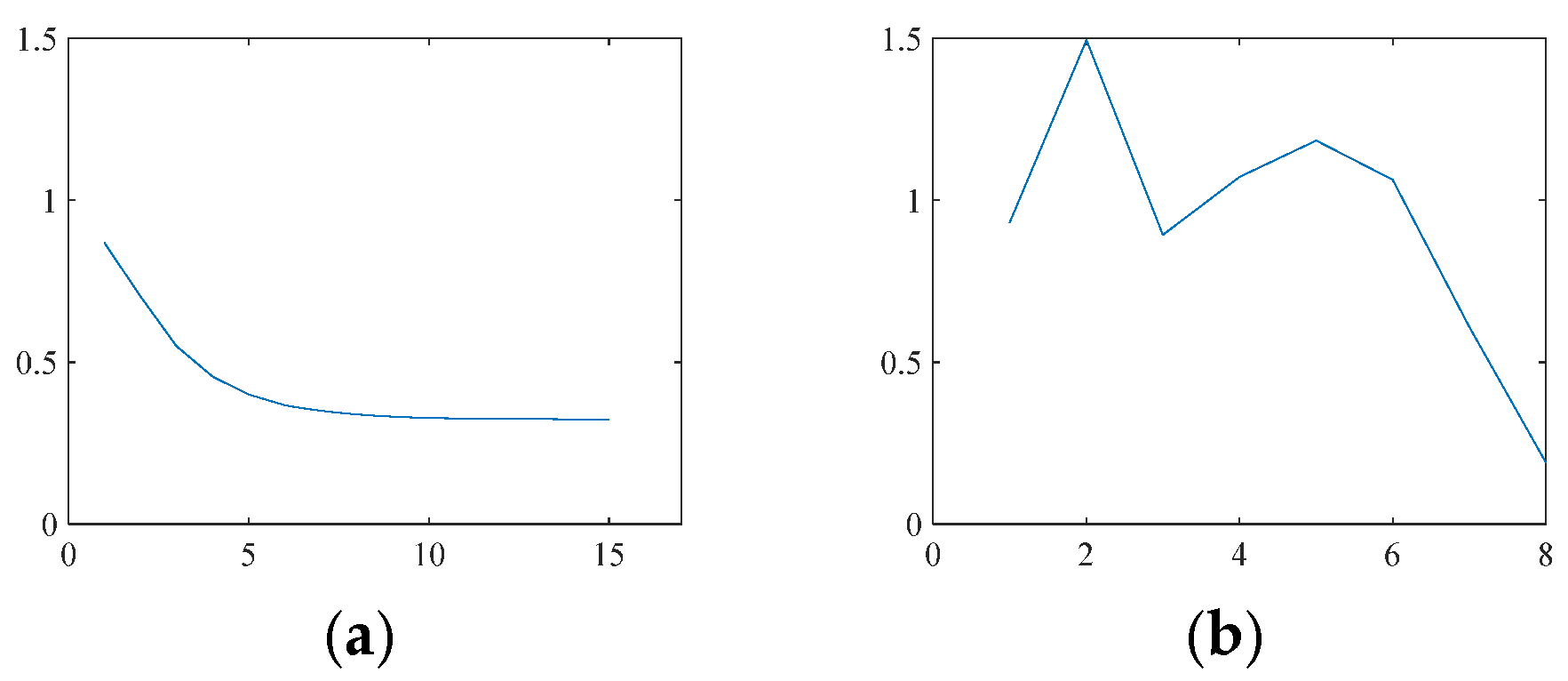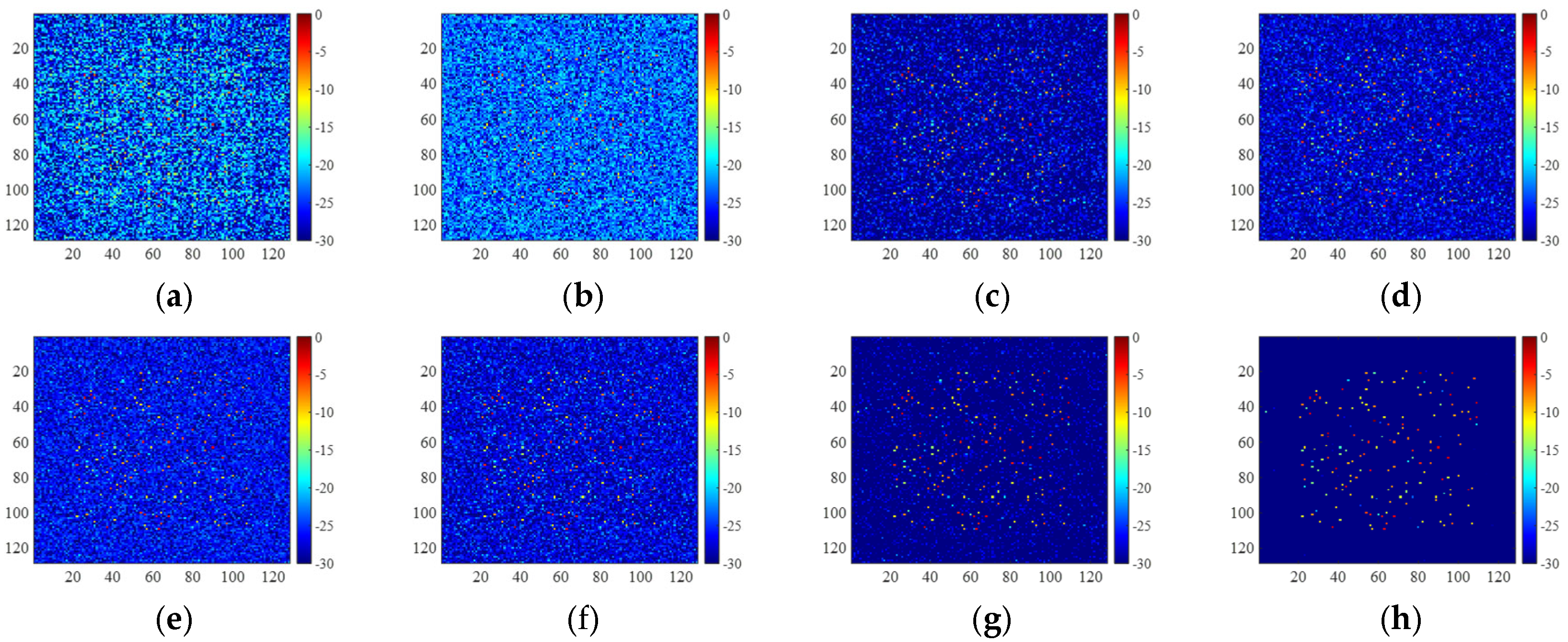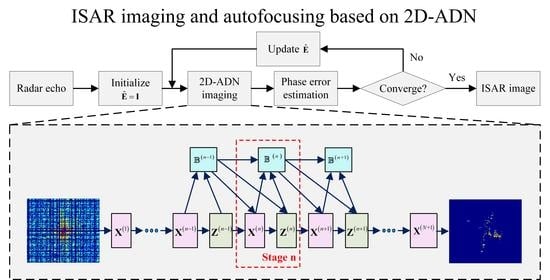1. Introduction
High-resolution inverse synthetic aperture radar (ISAR) imaging plays a significant role in space situation awareness and air target surveillance [
1,
2]. Under ideal observational environments with high signal-to-noise ratios (SNRs) and complete echo matrices, well-focused imaging can be acquired by classic techniques such as the range-Doppler (RD) algorithm and the polar formatting algorithm (PFA) [
3]. For a target with a small radar cross section (RCS) or a long observation distance, however, the SNR of the received echoes is low due to limited transmitted power. In addition, the existence of strong jamming and the resource scheduling of the cognitive radar may result in incomplete data along the range or/and azimuth direction(s). The complex observational environments discussed above, i.e., incomplete data and low SNRs, cause severe performance degradation or even invalidate the available imaging techniques. As ISAR images are generally sparse in the image domain, high-resolution ISAR imaging under complex observational environments based on the theory of sparse signal reconstruction has received intensive attention in the radar imaging community in recent years [
4,
5], in which the reconstruction of sparse images (i.e., the distribution of dominant scattering centers) from noisy or gapped echoes given the observation dictionary is sought.
In addition, the motion of the target can be decomposed into translational motion and rotational motion, where the former is not beneficial to imaging and needs to be compensated by range alignment and autofocusing. Traditional autofocusing algorithms can obtain satisfying imaging results from complete radar echoes [
6]. For complex observational environments, however, they cannot achieve good performance due to the deficiency of radar echoes and low SNRs. In recent years, parametric autofocusing techniques [
7] have been applied for sparse imaging. Although they are superior to traditional methods under sparse aperture conditions, their performance is dependent on imaging quality. Therefore, in turn, a better sparse reconstruction method is needed.
The available sparse ISAR imaging methods can be divided into three categories: (1) model-driven methods; (2) data-driven methods; and (3) combined model-driven and data-driven methods. Among them, model-driven methods construct the sparse observation model and obtain high-resolution images by
-norm or
-norm optimization. The
-norm optimization, e.g., orthogonal MP (OMP) [
8] and smoothed
-norm method [
9], cannot guarantee that the solution is sparsest and may converge to the local minima. The
-norm optimization, e.g., the fast iterative shrinkage-thresholding algorithm (FISTA) [
10,
11] and alternating direction method of multipliers (ADMM) [
12,
13], is the convex approximation of the
-norm [
14]. However, the regularization parameter directly affects the performance and how to determine its optimum value remains an open problem [
4]. Additionally, vectorized optimization requires long operating times and a large memory storage space. To improve the efficiency, methods based on matrix operations such as 2D-FISTA [
15] and 2D-ADMM [
16] are proposed.
Data-driven methods solve the nonlinear mapping from echoes to the 2D image by designing and training a deep network [
17]. In the training process, the target echoes and corresponding ISAR images are adopted as the inputs and the label, respectively, and the loss function is the NMSE between the network output and the label. In order to minimize the loss function (i.e., to obtain the optimal network parameters), the network parameters are randomly initialized and updated by the gradient descent method iteratively until convergence [
18]. Then, the trained network is applied to generate focused imaging of an unknown target. Facilitated by off-line network training, such methods achieve the reconstruction of multiple images rapidly, and typical networks include the complex-value deep neural network (CV-DNN) [
19]. Nevertheless, the subjective network design process lacks unified criterion and theoretical support, which makes it difficult to analyze the influence of network structure and parameter settings on reconstruction performance. In addition, the large number of unknown parameters require massive training samples to avoid overfitting.
The combined model-driven and data-driven methods first expand the model-driven methods into a deep network [
20], and then utilize only a few training samples to learn the optimal values of the adjustable parameters [
21]. Finally, they output the focused image of an unknown target by the trained network. Such methods effectively solve the difficulties in: (1) setting proper parameters for model-driven methods; (2) clearly explaining the physical meaning of the network; and (3) generating a large number of training samples to avoid overfitting for data-driven methods. A common technique to expand the model-driven methods is unrolling [
22], which utilizes a finite-layer hierarchical architecture to implement iterations. As a typical imaging network, the deep ADMM network [
23] uses measured data for effective training, which is usually limited due to observation conditions, and autofocusing is not considered for sparse aperture ISAR imaging.
To tackle the above-mentioned problems, this article proposes the 2D-ADMM-Net (2D-ADN) to achieve well-focused 2D imaging under complex observational environments, and its key contributions mainly include the following: (a) Mapping from the ISAR images to echoes in the wavenumber domain is established, which forms as a 2D sparse reconstruction problem. Then, the 2D-ADMM method is provided with phase error estimation for focused imaging. (b) Based on the 2D-ADMM, 2D-ADN is designed to include the reconstruction layers, nonlinear transform layers, and multiplier update layers. Then, the adjustable parameters are estimated by minimizing the loss function through back-propagation in the complex domain. (c) Simulation results demonstrate that the 2D-ADN, which is trained by a small number of samples generated from point-scattering model, obtains the best reconstruction performance. For both the complete and incomplete data with low SNRs, the 2D-ADN combined with random phase error estimation obtains better-focused imaging of measured aircraft data with a clearer background than the available methods.
The remainder of this article is organized as follows.
Section 2 establishes the sparse observation model for the high-resolution 2D imaging and provides the iterative formulae of 2D-ADMM with random phase error estimation.
Section 3 introduces the construction of 2D-ADN in detail.
Section 4 gives the network loss function and derives the back-propagation formulae in the complex domain.
Section 5 carries out various experiments to prove the effectiveness of 2D-ADN. In
Section 6, we discuss the performance of 2D-ADN, and
Section 7 concludes the article with suggestions for future work.
3. Structure of 2D-ADN
To tackle the aforementioned problems, we modified 2D-ADMM and expanded it into 2D-ADN. There are similarities between deep networks and iterative algorithms [
22] such as 2D-ADMM. Particularly, the matrix multiplication is similar to the linear mapping of the deep network, the shrinkage function is similar to the nonlinear operation, and the adjustable parameters are similar to network parameters. Therefore, the 2D-ADMM algorithm can be unfolded into 2D-ADN. As shown in
Figure 1, the network has
stages, and stage
,
, represents the
th iteration described by Algorithm 1. Typically, one stage consists of three layers, i.e., the reconstruction layer, the nonlinear transform layer, and the multiplier update layer, which correspond to (9), (10), and (11), respectively. The inputs of 2D-ADN are echoes in the 2D wavenumber domain, and the output is the reconstructed 2D high-resolution image. Below, we will derive the forward-propagation formulae of each layer.
3.1. Reconstruction Layer
As shown in
Figure 2, the inputs of the reconstruction layer are
and
, and the output is:
where the penalty parameter
is the adjustable parameter.
For
,
and
are initialized to zero matrices and thus the output is:
For , the output serves as the input of and . For , the output is adopted as the input of the loss function.
3.2. Nonlinear Transform Layer
As shown in
Figure 3, the inputs of the nonlinear transform layer are
and
, and the output is:
To learn a more flexible non-linear activation function, we substituted a piecewise linear function
for the shrinkage function [
29]. Specifically,
is determined by
control points
, where
and
denote the predefined position and adjustable value of the
th point, respectively. In particular, we performed the
on the real and imaginary parts of the complex signal, respectively.
For
,
is initialized as a zero matrix and the output is:
The output of this layer serves as the input of and .
3.3. Multiplier Update Layer
As shown in
Figure 4, the inputs of the multiplier update layer are
,
, and
, and the output is:
where the learning rate
is an adjustable parameter.
For
,
is initialized as a zero matrix and the output is:
For , the output of this layer serves as the input of , , and . For , the output is adopted as the input of the reconstruction layer.
4. Training of 2D-ADN
4.1. Loss Function
In this article, the loss function
is defined as the normalized mean square error (NMSE) between the network output
and the label image
, i.e., the ground truth of the scattering center distribution:
where
are the input echoes in the wavenumber domain defined by (14),
is the set of the adjustable parameters,
is the Frobenius norm, and
is the training set with
.
4.2. Back-Propagation
We optimized the parameters of 2D-ADN utilizing the gradient-based limited-memory Broyden–Fletcher–Goldfarb–Shanno (L-BFGS) algorithm. To this end, we computed the gradients of the loss function with respect to
through back-propagation over the deep architectures. Following the structures and writing styles of the available literatures dealing with deep networks [
30] and the conjugate complex derivative of composite function [
31], we derived the back-propagation of the three layers, respectively. To be consistent with the previous definition, the gradients of the matrices were expressed in matrix forms for convenience, and they were also calculated in matrix forms for efficiency.
As shown in
Figure 5, the gradient transferred to the reconstruction layer through
and
for
satisfies:
For
, the gradient of the loss function transferred to
equals to:
The gradient of
is:
where:
and the gradients transferred to
and
are calculated by:
where:
where
represents the matrix with all ones:
where:
As shown in
Figure 6, the gradient transferred to the nonlinear transform layer through
and
satisfies:
The gradient calculations of
,
, and
are consistent with the derivation of the piecewise linear function defined in [
29].
As shown in
Figure 7, the gradient transferred to the multiplier update layer through
,
, and
for
satisfies:
For
, the gradient transferred from the last reconstruction layer to
is:
The gradient of
is:
where:
and the gradient of this layer transferred to
,
and
are calculated by:
where:
where:
where:
The training stage can be summarized as follows:
Step1: Define the NMSE between the network output and the label image as the loss function;
Step2: Back-propagation. Calculate the gradients of the loss function with respect to the penalty parameter, the piecewise linear function, and the learning rate of each stage;
Step3: Utilize the L-BFGS algorithm to update the network parameters according to their current values and the gradients;
Step4: Repeat Step2~Step4 until the difference between the loss functions of the two adjacent iterations is less than 10−6.
For multiple training samples, we utilized the average gradient and loss function.
4.3. 2D High-Resolution ISAR Imaging Based on 2D-ADN
According to the above discussions, high-resolution 2D ISAR imaging based on 2D-ADN includes the following steps:
Step1: Training set generation. Initialize the phase error matrix , construct and according to the radar parameters and data missing pattern, generate randomly distributed scattering centers with Gaussian amplitudes, calculate according to (1), and obtain the data set .
Step2: Network training. Initialize the adjustable parameters , and utilize to train the network according to Section IV-B.
Step3: Testing. For simulated data, feed echoes in the wavenumber domain into the trained 2D-ADN and obtain the high-resolution image. For measured data with random phase errors, estimate the high-resolution image and random phase errors by the trained 2D-ADN and (13) iteratively until convergence.
As the distribution and the amplitudes of simulated scattering centers mimic true ISAR targets, optimal network parameters suitable for measured data imaging can be learned after network training. By this means, the issue of insufficient measured training data is effectively tackled.
In 2D-ADN the number of stages
determines the network depth. It is observed that the loss function first decreases rapidly and then tends to be stable with the increment of
. Therefore, we choose
according to the convergence condition given below:
where
is the loss function of the trained network with
stages,
is the loss function of the trained network with
stages, and
is a threshold.
For a single iteration, 2D-ADN and 2D-FISTA share the same computational complexity of . As the number of stages in 2D-ADN is much smaller than the number of iterations required for 2D-FISTA to converge, the computational time of 2D-ADN is shorter.
5. Experimental Results
In this section, we will demonstrate the effectiveness of 2D-ADN by high-resolution ISAR imaging of complete data, incomplete range data, incomplete azimuth data, and 2D incomplete data. The SNR of the range-compressed echoes is set to 0 dB by adding Gaussian noise, and the loss rate of the incomplete data is 50%.
For network training, 40 samples are generated following Step1 in Section IV-C, and a typical label image is shown in
Figure 8a. Specifically, the first 20 samples constitute the training set and the rest constitute the test set. Later experiments will demonstrate that a small training set is adequate as unfolded deep networks have the potential to developing efficient high-performance architectures from reasonably sized training sets [
22].
In the training stage, the adjustable parameters are initialized as
and
. In addition, the piecewise linear function is initialized as a soft threshold function with
, and the control points are equally spaced with
. Then, the 2D-ADN is trained following
Section 4.2, and the number of stages is set to 7 according to (40).
For the simulated test data, we fed the test samples into the trained 2D-ADN, and calculated the NMSE, the peak signal-to-noise ratio (PSNR), the structure similarity index measure (SSIM), and the entropy of the image (ENT) according to the output and the label for quantitative performance evaluation. In addition, we compared the imaging results of the 2D-FISTA, untrained 2D-ADN, UNet [
32], and trained 2D-ADN. In particular, as a data-driven method, the UNet has much more trainable parameters than the 2D-ADN. To avoid overfitting, we generated 1000 samples as the simulated data set, where 800 samples constituted the training set and the rest constituted the test set. The network was trained by 28 epochs, and the training time was 22 min. For 2D-ADN, the training terminated when the relative error of the loss fell below
, and the training time was 19 min. For 2D-FISTA, the parameters were initialized as
and the algorithm terminated when the image NMSE in adjacent iterations fell below
.
Additionally, we fed the measured data of a Yak-42 aircraft with random phase errors into the trained 2D-ADN and obtained the high-resolution imaging in various observation conditions. The original RD image with complete data and high SNR is shown in
Figure 8b. The algorithm terminated when the NMSE between adjacent iterations fell below
.
The imaging results were obtained with MATLAB coding without optimization, using an Intel i9-10920X 3.50-GHz computer with a 12-core processor.
5.1. Complete Data
For the test sample illustrated in
Figure 8a, imaging results are shown in
Figure 9 and the corresponding metrics are shown in
Table 1. It was observed that the image obtained by 2D-FISTA and untrained 2D-ADN are noisy with spurious scattering centers. On the contrary, the image obtained by trained 2D-ADN has the smallest NMSE and ENT, and the highest PSNR and SSIM, demonstrating its superior imaging performance. In addition, 2D-FISTA has the longest running time due to slow convergence. The UNet obtains satisfying denoising performance and has the shortest running time of only 0.01 s.
For measured data of the Yak-42 aircraft, imaging results are shown in
Figure 10 and the corresponding entropies and running times are shown in
Table 2. Compared with the available methods, the trained 2D-ADN obtained better-focused images with a clearer background. In addition, the running time increased because 2D-ADN was implemented multiple times for phase error estimation. The untrained 2D-ADN had the longest running time since the strong background noise hindered fast convergence.
5.2. Incomplete Range Data
The data missing pattern of the incomplete range data is shown in
Figure 8c, where the white bars denote the available echoes and the black ones denote the missing echoes.
For the same test sample, the reconstruction results are shown in
Figure 11, and the metrics for quantitative comparison are shown in
Table 3. Still, the trained 2D-ADN demonstrated the best reconstruction performance.
For the same measured data of the Yak-42 aircraft, the reconstruction results are shown in
Figure 12, where the trained 2D-ADN generated better-focused images with a clearer background than other methods. The corresponding entropies and running times are shown in
Table 4, where 2D-FISTA has the longest time.
5.3. Incomplete Azimuth Data
The data missing pattern of the incomplete azimuth data is shown
Figure 8d. For the same test sample, the reconstruction results are shown in
Figure 13, and the metrics for quantitative comparison are shown in
Table 5.
For the same measured data, the imaging results are shown in
Figure 14, and the corresponding entropies and running times are shown in
Table 6. Similarly, 2D-ADN achieved well-focused imaging with the shortest running time.
5.4. 2D Incomplete Data
The data missing pattern of the 2D incomplete data is shown in
Figure 8e. For the same test sample, the reconstruction results are shown in
Figure 15, and the metrics for the quantitative comparison are shown in
Table 7.
For the same measured data, the reconstruction results are shown in
Figure 16, and the corresponding metrics are shown in
Table 8, which demonstrate the superiority of 2D-ADN over the other available methods under complex observation conditions.
7. Conclusions
This article proposed 2D-ADN for high-resolution 2D ISAR imaging and autofocusing under complex observational environments. Firstly, the 2D mapping from the ISAR images to echoes in the wavenumber domain was established. Then, iteration formulae based on the 2D-ADMM were derived for high-resolution ISAR imaging and, combined with the phase error estimation method, an imaging and autofocusing method was proposed. On this basis, the 2D-ADMM was generalized and unrolled into an -stage 2D-ADN, which consisted of reconstruction layers, nonlinear transform layers, and multiplier update layers. The 2D-ADN effectively tackles the parameter adjustment problem of model-driven methods and possesses more interpretability than data-driven methods. Experiments have shown that after the end-to-end training by randomly generated samples off-line, the 2D-ADN achieves the better-focused 2D imaging of measured data with random phase errors than the available methods while maintaining computational efficiency.
Future work will be focused on designing network architectures which incorporate residual translational motion compensation and 2D imaging, and on designing noise and jamming-robust network architectures in a Bayesian framework.

